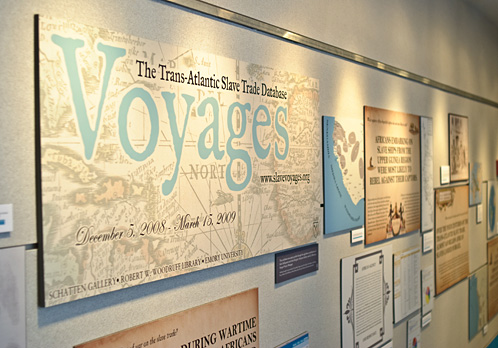Spring 2009: Of Note

The Trans-Atlantic Slave Trade Database debuted with an exhibit at the Schatten Gallery.
Aaron Dill/Special
To see the slideshow, please enable Javascript and Flash Player.
Traces of Tragedy
An online database developed through Emory libraries sheds new light on the slave trade
Slave trade database brings little-known facts to virtual life
During four centuries of the Trans-Atlantic slave trade, almost 4.9 million African slaves landed in Brazil. The plantation economy of Brazil and its harsh working conditions contributed to the millions of Africans carried there. Only 3.6 percent of the entire estimated volume of the slave trade arrived in North America.
Africans embarking on slave ships from the Upper Guinea region, constituting Senegambia, Sierra Leone, and the Windward Coast regions, were most likely to rebel against their captors. Resistance took the form of insurrection aboard ship, attack from the shore, or individuals jumping overboard.
Of the millions of Africans forcibly transported through the slave trade, nearly half set sail from ports in West Central Africa. This is probably because the Congo River, with its many tributaries, stretched deep into the heart of the continent and provided swift passage for Africans caught and traded in the interior to be transported to slaving ports along the coast.
The length of the Middle Passage decreased over time as a result of technological improvements to ships and sailing methods, subsequently improving both captives’ and crews’ chances of survival.
Related Site
Related Video
The Transatlantic Slave Trade Database (Emory University's YouTube Channel)
By Mary J. Loftus
On the Fabiana, there was Bora, a thirty-year-old male, and Lugra, a fifteen-year-old female, who disembarked in Sierra Leone in 1819. Babash, a twenty-eight-year-old male, was on the Anna Maria, embarking from Bonny in 1820.
And so the names scroll on, more than 67,000 of them, gathered from records kept during the four centuries of the slave trade, when more than 12 million Africans were forcibly transported across the Atlantic Ocean to the Americas.
Bringing together a group of world slave trade researchers with an innovative team of Emory digital library development experts, scholars have revised an already existing database of slave trade voyages, making the material available for free on the Internet for the first time.
Voyages: The Trans-Atlantic Slave Trade Database project expands on the seminal 1999 CD-ROM The Trans-Atlantic Slave Trade, which included more than 27,000 slaving expeditions.
“We’re trying to do for African Americans what’s been done for Euro-Americans already,” said Robert W. Woodruff Professor of History David Eltis, one of the scholars who published The Trans-Atlantic Slave Trade. Eltis and Martin Halbert, director of digital programs and systems for Emory’s libraries, are directing the project. “What the database makes possible is the establishment of links between America and Africa in a way that already has been done by historians on Europeans for many years.”
Because slaves experienced a coerced migration, there was actually more detailed record keeping; the human trade was a business. The Voyages database is made up of nearly 35,000 individual slaving expeditions between 1514 and 1866. Records of the voyages were found in archives and libraries around the Atlantic that provided information about vessels, traders and owners, enslaved peoples, and trading routes.
Two years in the making, the expanded database includes auxiliary materials such as maps, ship logs, and manifests. The site allows users to search for information about a particular voyage, date, time frame, ship name, place of origin, and African name. The intent, Eltis says, is for everyone from genealogists to grade-schoolers to be able to use the site effectively.
The project has received funds from several sources, including $324,000 from the National Endowment for the Humanities and $25,000 from Harvard’s W. E. B. Du Bois Institute for African and African American Research. “This is more than a capstone to half a century of research,” said Henry Louis Gates Jr. of the Du Bois Institute. “It is a way of marrying scholarship with the wide general interest in the slave trade that has developed.”